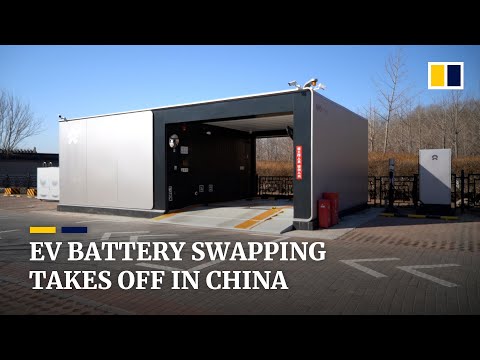Chinese smart-battery swap stations can change EV batteries automatically
China’s Battery Swap Revolution: Fast, Smart, and Ready for the World
When it comes to electric vehicle infrastructure, China is charging ahead—literally. But it’s not just plugging in that’s getting a tech makeover. Enter battery swapping, the fast, automated solution that’s turning EV charging time on its head. Spearheaded by innovators like NIO and CATL, China’s smart-battery swap stations are reshaping how drivers power their rides and redefining what scalable EV infrastructure looks like in 2025 and beyond.
How Do Battery Swap Stations Work?
Picture this: you pull into a compact facility, sensors guide your car into place, and robotic arms go to work. In under five minutes, your depleted battery is out and a fully charged one is in. No waiting, no plugging in, no coffee-fueled half-hours by a charging pole. This is battery swapping—China style.
Stations like NIO’s second-generation models use AI, cloud platforms, and robotics to make swaps seamless. Each battery is monitored, recharged, and maintained centrally, boosting safety and lifespan while minimizing driver downtime. The result? An ownership experience that feels more like topping off a gas tank than managing a charging schedule.
NIO Leads the Way With BaaS and Next-Gen Swapping
NIO didn’t just pioneer swapping—they’ve scaled it. From launching their first station in 2018 to deploying over 800 by early 2022, and now closing in on 1,300 stations, NIO has gone from concept to national network. The second-gen swap stations cut the process to just 2–3 minutes and integrate with NIO’s cloud platform for real-time diagnostics and maintenance tracking.
Their Battery-as-a-Service (BaaS) model is also a game changer. By leasing batteries instead of selling them, NIO slashes upfront EV costs while giving users the option to upgrade batteries later. It’s a win for flexibility, affordability, and sustainability—especially for urban drivers or fleet operators who prioritize uptime.
CATL, Aulton, and the Industry Push Toward Interoperability
Battery swapping isn’t a one-brand show. CATL, the world’s biggest EV battery maker, launched its EVOGO platform to deliver modular, interchangeable packs that work across vehicle models. Meanwhile, Aulton New Energy is carving out a niche with thousands of stations for commercial fleets—think buses, taxis, and delivery vans.
BAIC and Geely are also in on the game, deploying battery swap-compatible EVs and forming partnerships to standardize tech. The goal? Interoperability. Universal compatibility would allow cross-brand use of stations—a key to making swapping as common as charging.
Why Battery Swapping Beats Fast Charging in Key Areas
Swapping’s biggest win? Time. Where even fast chargers take 30–60 minutes, swaps are done in 3–5. But the perks don’t stop there. Centralized charging under controlled conditions extends battery life and reduces degradation. Plus, swap stations can double as grid stabilizers, charging during off-peak hours and feeding power back to the grid via vehicle-to-grid (V2G) tech.
NIO’s stations are compact, modular, and easier to deploy than traditional charging hubs—especially in areas with limited grid access or space. Add in the cost advantage of BaaS, and you’ve got a model that solves affordability and infrastructure hurdles in one go.
Challenges: Standardization, Scale, and Consumer Perception
Still, it’s not all green lights. Most EVs use proprietary battery designs, which makes standardization difficult. CATL’s EVOGO is a step in the right direction, but mass adoption will take cross-industry cooperation. There’s also the upfront cost of building swap stations and managing massive battery inventories—a logistical and financial hurdle even for big players.
Then there’s consumer trust. Some drivers balk at the idea of not owning their battery or swapping it out regularly. Changing those perceptions will require transparency, reliability, and education—alongside better B2B integration for fleet operators who already see the benefit.
Government Policy and Global Expansion Fuel the Shift
China’s NEV policy framework has been battery swapping’s rocket fuel. By treating swap stations as critical infrastructure and offering subsidies, the government has paved the way for rapid expansion. In 2020, battery swap tech got priority status—unlocking billions in investment and R&D.
Globally, China is setting the bar. NIO began deploying stations in Norway in 2021 and plans further European expansion. Meanwhile, U.S.-based Ample and Taiwan’s Gogoro are trying out similar models for cars and scooters. But with government backing, scale, and user adoption on its side, China remains the epicenter of smart-battery swap innovation.
What’s Next for Battery Swapping in China?
Looking ahead, swapping is poised to get faster, smarter, and greener. Next-gen stations may offer under-two-minute swaps, integrate renewables, and support AI-powered fleet diagnostics. Industry consortiums may push for universal battery standards to make interoperability a reality.
Commercial fleets—taxis, ride-hailers, logistics—stand to benefit the most. For them, downtime is money, and battery swapping slashes it to near zero. As cities become smarter and mobility gets more modular, expect swap stations to become cornerstones of urban infrastructure—powering vehicles, stabilizing grids, and even storing surplus energy.








